Description of the properties and varieties of the plant.
Contents
- What is the young, its types and varieties, how does it blossom?
- Molodilo - a stone rose: magical properties, signs and superstitions
- Molodilo from seeds how to grow?
- Molodilo: planting and care in the open ground
- How does the juvenile multiply?
- How to keep young in winter: wintering in the open ground
- Echeveria and youthful difference
- Growing young in a pot in the room conditions
- How to apply molodilo in landscape design?
- Molodilo - flower stone rose in the cemetery
- Video: Molodilo in your garden
In this article you will learn about such an unusual plant with a very interesting name "molodilo".All the secrets and properties of this plant further.
What is the young, its kinds and varieties, how does it blossom?
The young is a very beautiful perennial plant that does not require special care. It will perfectly decorate any yard, it can be used to create an alpine hill. Also, a very fascinating creative process of creating from different types and varieties of this flower miracle interesting compositions. It is simply impossible not to fall in love with it, it strikes with its rich appearance, unusual form and has medicinal properties.
Young is an evergreen, durable, 20 centimeter plant with a straight stem, fleshy leaves, pointed top and covered with a special film that protects against the rapid evaporation of moisture. Spiral-like leaves grow around the rosette in the form of a cocoon. They fit tightly together, forming small balls. Its roots do not penetrate deep into the earth, but are on top.
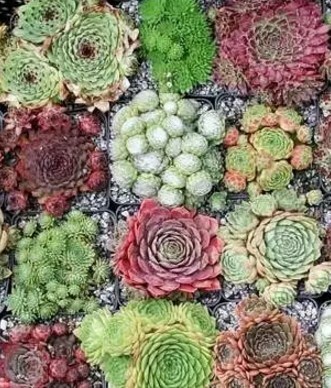 Molodilo
Molodilo That is why, very long time this plant was planted on the roofs of houses, it looked very unusual, but at the same time is environmentally friendly. Flowers of different shapes, colors and heights.
Since these plants are not whimsical and do not require special efforts in growing, there are many species, varieties and even hybrids that impress with their unusual beauty. The area of their growth is very great: from Asia and Northern Africa and right up to the Central part of Europe.
Molodilo can change their color in sunny weather, with excellent soil, which meets all the necessary characteristics for this variety and species, depending on the season, as well as their intensive growth.
Each of the existing species differs not only in coloring, rapid growth of leaves, the size of the plant and the structure of the rosettes, but also in the speed of reproduction, in the size and shades of the flowers, in the height of the peduncles and in the time of flowering and fading. Let's take a closer look at what kinds of this wonderful plant exist and please many people with its beauty:
- The young that reproduces with shoots , grows mainly near the great lakes , where suffices moistened soil, lots of sunlight .Greenish with red edges of the sprouts, form a spiral, holding on thin stems, which for rooting young shoots it is desirable to break off.
- The spiderweb was young with small sprouts only two centimeters wide. This name it received because of the many small villi in the middle, which resemble cobwebs.
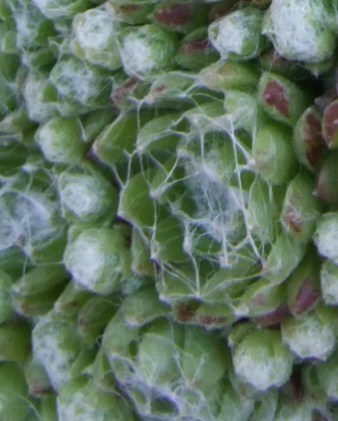 The web became young
The web became young - The roofing was very young all over the world. It was from him that experienced gardeners brought out new varieties or crossed existing ones to produce hybrids. It has a large rosette, with a width of up to ten centimeters. The leaves are massive, their edges have a reddish hue. Flowers can be of different shapes and shades.
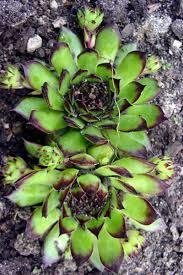
- roofing species mountain varieties have very large processes and leaves at the base of a very rich green color, they delight in their beauty of all tourists who like to breathe clean air and see the beauty of the area from the mountainous heights of the Caucasus. A plentiful flowering falls on July - the middle of August.
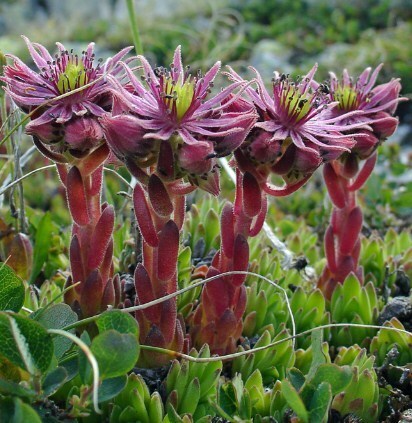 Mountain young
Mountain young - Russian grew young in the forest-steppe zone, it also has green leaves and a rich, bright flower and a long flower spike.
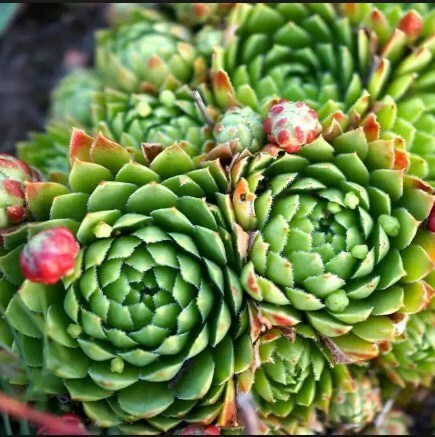 Russian Molodilo
Russian Molodilo - The spherical grew young and can be found on the slopes of the famous Caucasian mountains. The width of its rosette is only three centimeters, and the green leaves, shimmering in the sun, give off a slight reddish shade.
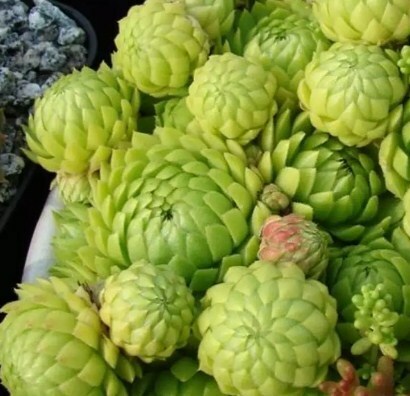 Ball-shaped fry
Ball-shaped fry - The marble was young to bewitch with the depth of color and the diameter of the sockets, which can be up to twelve centimeters. The leaves are gently green, with patches of red.
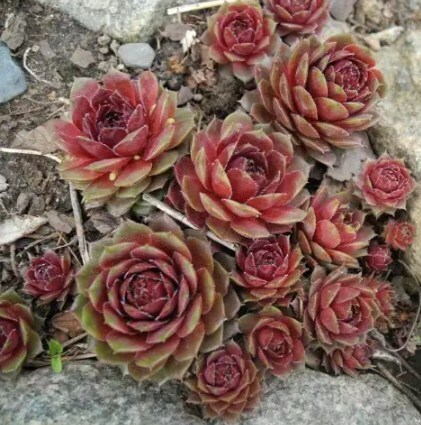 Marble fry
Marble fry - The sandy leaves were smooth with red edges, the shoot can be up to fourteen centimeters wide and two centimeters high.
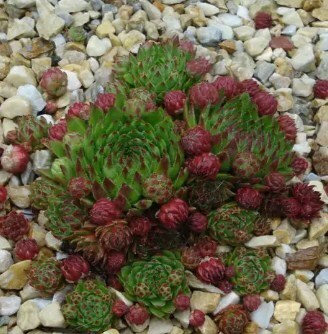 Sandy fry
Sandy fry - Inflorescences of small grew young average of seven flowers of purple color with a contrasting line along the entire length of the petals.
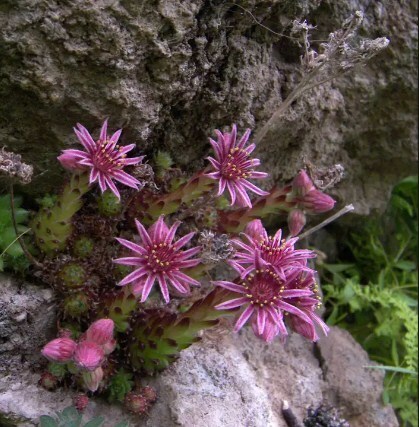 The youngest young
The youngest young Such popular varieties of this famous plant are very popular:
- grade "Princess" is very suitable for creating floral ornaments, green balls with a dark brown coating
- It goes well with "Pharaoh" with leaves of rich purplecolors with a green covering.
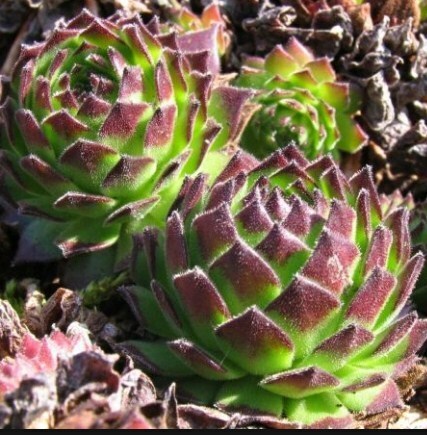 Variety "Pharaoh"
Variety "Pharaoh" - Hybrid "Montana" has a rich green shoots with a delicate purple spraying.
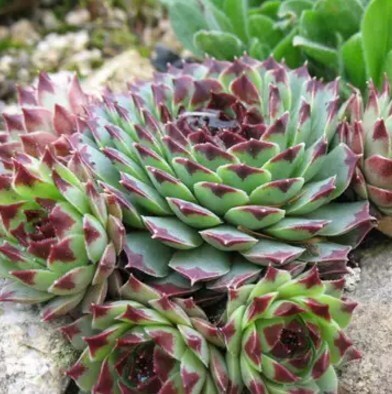 Montana
Montana - And here the grade "Julia" strikes with the width of marshy rosettes, which begin to blush by the arrival of the first autumn cool.
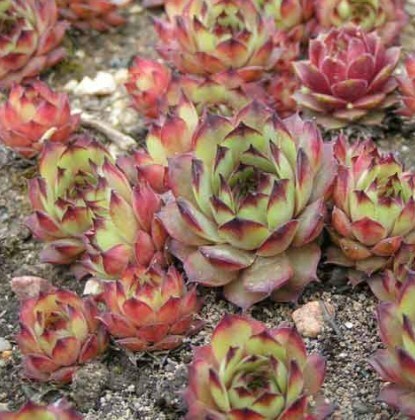 "Julia" in the autumn
"Julia" in the autumn Every process of a stone rose blooms only one single time, after the blossoming it dies off, new ones grow out of the remaining small children. Adults, ingrained young, blossom much faster and during the flowering time to grow many children, but young - no.
The blooming has been abundant and long lasting during the hot summer months, pleasing the hosts and passers-by. Colors are various, for any color and taste.
Molodilo - a stone rose: magical properties, signs and superstitions
Even in ancient times, this flower was grown for medical purposes, believed that the leaves collected during the flowering period have the magical properties of and will be able to cure any diseases( mostly these were juvenilesroofing):
- Various pulmonary diseases( did a special medicine with the use of leaves that were young, insisted it and drank before eating).
- Skin diseases( fresh leaves applied to bites, burns, special infusion treated wounds, and with the help of fresh juice get rid of freckles).
- Cardiac diseases( ground leaves with the addition of flower honey improve blood circulation and accelerate the work of the heart).
- To prevent viral diseases and strengthen immunity, it is recommended to add soaked in cold water, green leaves.
- The aboveground part of the young was actively used in folk medicine for treatment of various types of diseases.
- With various nerve diseases, is recommended to drink a decoction of young, it is soothing to the entire body and helps to relieve stress.
- Infusion of leaves used with increased pressure and with various eye diseases .All medicinal properties are preserved only in fresh or boiled leaves, when they dry up - all the medicinal properties are lost.
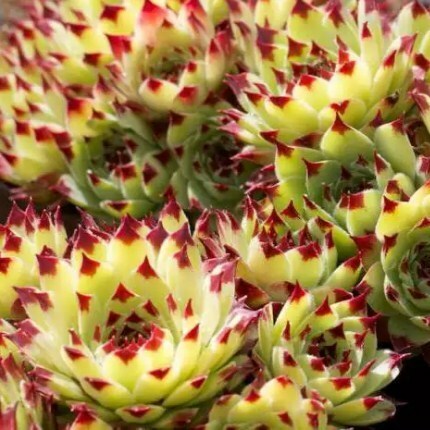 Molodil actively used in folk medicine
Molodil actively used in folk medicine The Greeks considered this plant capable of protecting the house from evil, negative energy and withdrawing lightning; for this purpose, special varieties were planted on the roof; this sign was preserved even in the Middle Ages, this plant was planted not only on the roofs of houses, but also on farm buildings, forprotection of all living and intimate. Thus, to the present day the form of roofing youngsters has reached. People noticed that where the flower grows, thunder never rumbles.
Also, the Greeks believed that if you eat juvenile food, no poisons are terrible, the body is protected and filled with strength and energy. Known healers, piously believed in a sign that the rosette of this flower, protects a person from the bite of a poisonous scorpion, and increases the resistance of the body to various diseases, retains excellent vision and hearing.
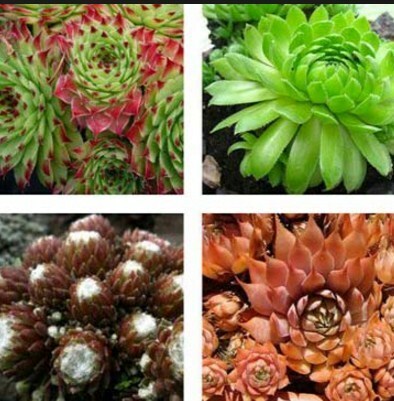 Molodilo has a diverse form and color.
Molodilo has a diverse form and color. . Since this plant does not require special care, it quickly takes root in a new place, many people plant it on the graves of their relatives and near, along with thujas, birches, roses and tulips. It is widespread superstition that the youngest should be planted only in a quiet, peaceful place, to protect those who have gone to the Kingdom of Heaven.
At home such a plant is unsuitable, as it causes different associations. It all depends on how a person treats everything, whether he considers it a bad sign or not. The main thing is that this flower is worthy of attention, and it strikes us with its beauty every year more and more.
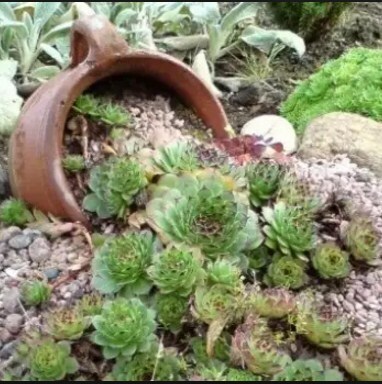 Molodilo used for landscape design
Molodilo used for landscape design Molodilo will perfectly decorate any terrain, and will warm the heart and soul of its owners. It is actively used to create various wedding bouquets and as an unusual decor. The choice is only for you. The main thing is to believe what your heart tells you, but it is never wrong.
Molodil from seeds how to grow?
The plant propagates sockets, but it can also be grown from seeds, although new species and varieties grow not very beautiful, but there are exceptions to everything. This process takes a lot of time and requires a lot of effort, but the result is worth it.
When you see that the work you invested pleases not only you, but all those around you - this is true happiness. Plant seeds in winter, so that they are better rooted and adapted to temperatures, and in the spring, so that they grow more intensively, and even during the hot summer period.
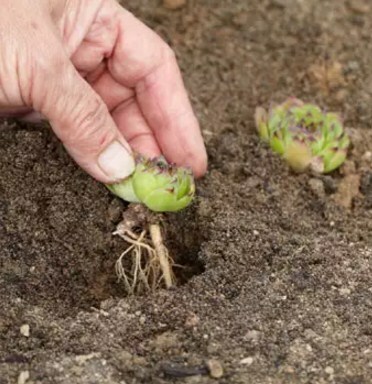 Molodil multiplies by rosettes
Molodil multiplies by rosettes . It can be planted directly in the designated area, or in pre-prepared pots. In room conditions it was much easier to grow young, it is protected from various influences from outside. Sow the seeds on the surface, not going deeper, in order that they quickly sprouted need to water the soil very carefully, because the shoots are very thin, miniature, which sometimes can not be distinguished from the young, only the grass that turned out to be.
When the sprouts grow and become stronger, the rosette will start to form, which after a certain period will begin to grow and there will be babies that need to be cut off. So from a small seed grows through time such a beautiful plant.
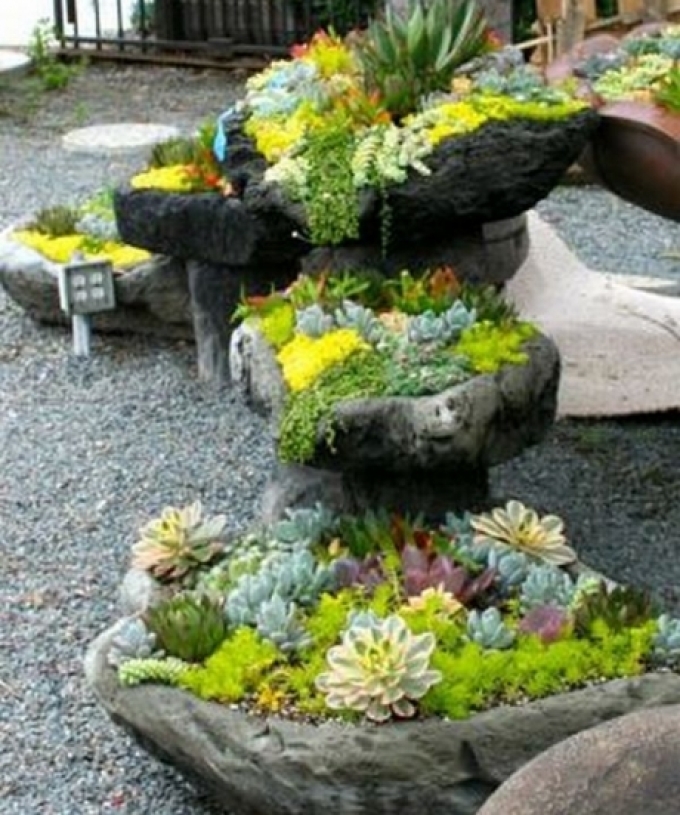 Molodilo will delight you with its beauty
Molodilo will delight you with its beauty Once planted it, you can not deny yourself the pleasure of enjoying its flowering, and the courtyard decorated with its help will be filled with a mysterious, fabulous atmosphere.
You can choose a series of varieties with different but well-matched shades by choosing interesting containers for this: old baskets, clay pots, old shoes, tractor tires and stuff. For beauty, you can decorate them with different colors. Fill your life with bright colors!
Molodylo: planting and care in the open ground
Before planting young shoots in the open soil, it is necessary to prepare a suitable place in advance. It should be well lit, moistened and cleared of various weeds. If molodilo receives a limited amount of sunlight, then the flower stem is stretched.
This plant is very harmoniously combined with natural stones, especially if they are beautifully decorated. They fit perfectly on huge arrays or in the foreground.
Molodilo does not require careful care, the main thing is to ensure that other plants do not prevent it from growing, and there was no excess moisture.
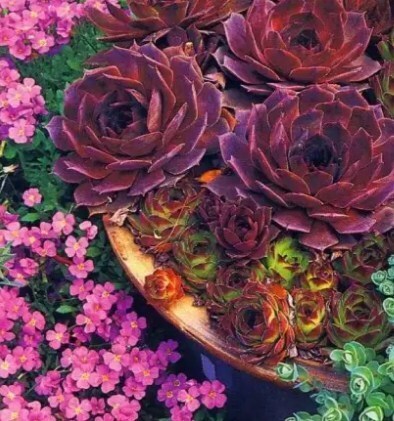 Molodilo
Molodilo The distance between the shoots depends on their size, because a small distance will interfere with normal growth, and in the future it will be necessary to plant them. After landing in the open ground, the young should be watered, then it is necessary to water it only on very hot days.
Due to its massive leaves, it retains moisture for a long time and does not require fertilizing the ground every year. He is quite enough to please his beauty. It is necessary in time to swell the soil to retain moisture and watch for other plants that grow near it. In time, remove dry parts.
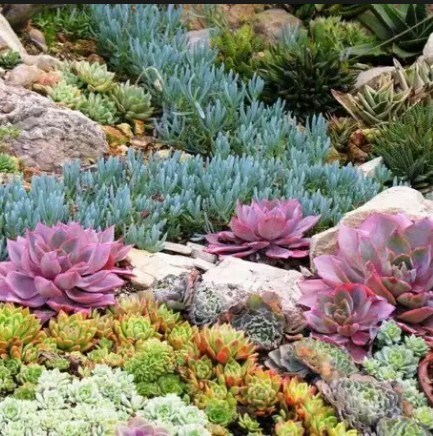 Molodil can not stand only very harsh winters
Molodil can not stand only very harsh winters The more often you harvest the weeds, the plant will grow intensively. A minimum of effort is a great result! In the case of harsh and protracted winters, it is better to take care of the plant before the first frosts - sprinkle with earth and cover with a film.
If young grew in a pot, then bring it into the room, and with the advent of spring take it out into the yard, and when the soil gets warmer, drop it off into the open country.
How does the juvenile multiply?
This plant propagates vegetatively. Small buds appear, and shoots-whiskers of different lengths extend in different directions from each side. The maximum length can be 30 cm.
Molodilo grows very quickly and needs to be thinned periodically, in order to have large flowers. Before planting the shoots, the ground is well watered.
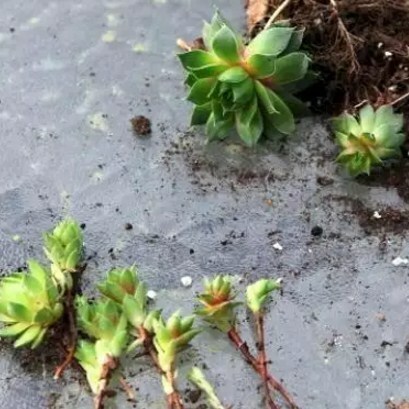 Molodil propagates vegetatively
Molodil propagates vegetatively If you want to plant this plant at home, it is better to do it in the first months of spring, if you do not have time, then summer and the first months of autumn, until the first frosts are ideal for landing in the ground. Scions within a month take root in a new place. Some shoots get very well and others get very sick, wither and disappear, and in strong winds, they can be blown off, as they are weakly attached to the
stalk. How to keep young in winter: wintering in the open ground
Molodilo - the plant is resistant to low temperatures,frost. Therefore, even in winter you will not have to deal with it very much. It is not necessary to cover it for the winter, especially with a film. It will not freeze out in the spring, but if the stone rose is under cover, there is a possibility of death of the plant due to the debate.
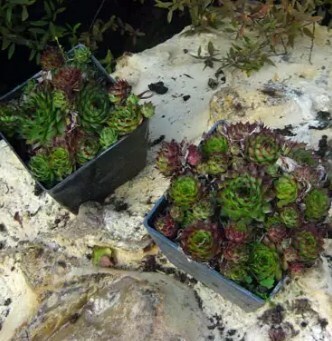 Molodilo is quite resistant to freezing
Molodilo is quite resistant to freezing You can cover lapnika only with young plants that will be wintering for the first time on the street. In addition, professional gardeners are advised to protect valuable varieties of young.
This can be done with a plastic bottle and then the young will delight you for more than one year.
In case of spring detection of dry outlets, they should be removed and replaced with new ones. If you do not do this, it's okay, as it's getting younger and it's reproducing itself perfectly and quickly.
Echeveria and the youngest difference
Quite often people think that it was young and echeveria is the same flower, but this is a mistaken opinion. They belong to the same family, so they are a bit similar. But there are differences in them:
- More than was frost-bitten .It will perfectly feel on the street at sub-zero temperatures, and echeveria, on the contrary, does not tolerate low temperatures, it should be stored only in the warmth.
- Molodilo lets out the antennae, while the echeveria does not have such a feature.
- Echeverion has a stem, but it does not grow young.
- The leaves of the sempervivum are thinner and more elegant in appearance, unlike echeverries. And the flowers of these two plants are different.
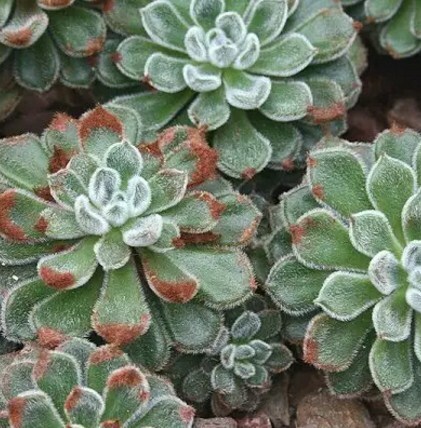 Echeveria, do not confuse with molodilom
Echeveria, do not confuse with molodilom So, if you want a more unpretentious to the temperature regime and a hardy plant, it is worth picking the young.
Growing young in a pot in a roomy environment
If anyone thinks that a stone rose is such a flower that grows only in the garden outdoors, then this is a mistake. This plant excellently feels and in pots in the room conditions.
It is not whimsical at all and will be excellent in any soil, even poor in minerals. Rare watering also does not hurt the plant. And in addition, the young perfectly feels even when the air is very dry.
Another advantage of a stone rose is that it is not afraid of pests, it rarely gets sick. But even in spite of all the advantages, there are several recommendations on how to keep a plant in a house or apartment:
- do not place it in dark, unlighted places. Molodilo loves the sun's rays, if the sun is not enough, then the young will lighten and lose its bright appearance.
- water the plant no more than once every two weeks and try to do so that the rosettes do not get a drop of water.
- in the heat of the day put the pot in the shade.
- in summer, a stone rose in a pot put on the balcony or courtyard.
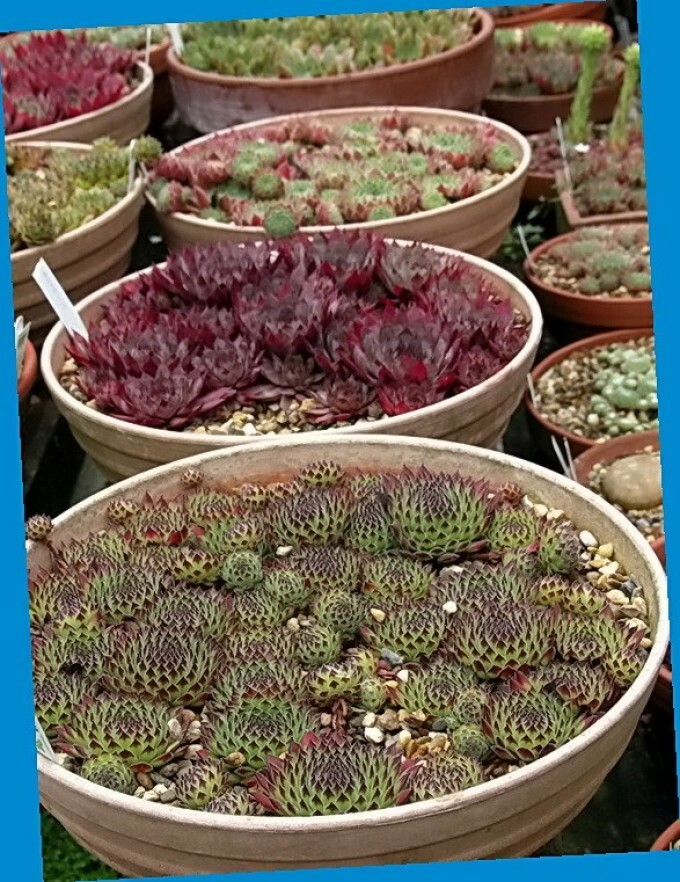 Molodilo grows well and in room conditions
Molodilo grows well and in room conditions How to apply molodilo in landscape design?
To date, the fashion is not the first year of beautiful compositions in combination with flowers, stones, wood and other natural ingredients that adorn the gardens and small flower beds. To create such compositions, the stone rose is ideal.
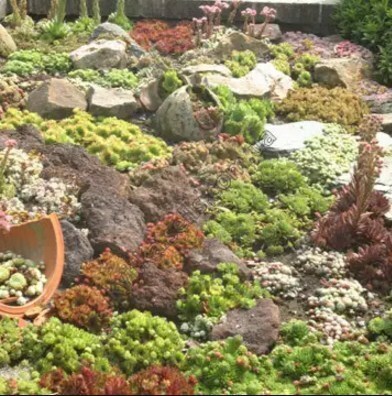 Molodilo is widely used in landscape design.
Molodilo is widely used in landscape design. Molodilo is very popular among garden interior designers. Designers widely use the plant to create magnificent alpine slides, paths, carpets in gardens, flower beds and whole paintings and compositions on stony or sandy surfaces. In addition, as in the past, and now, the young were often used for the original decoration of roofs of houses and arbors.
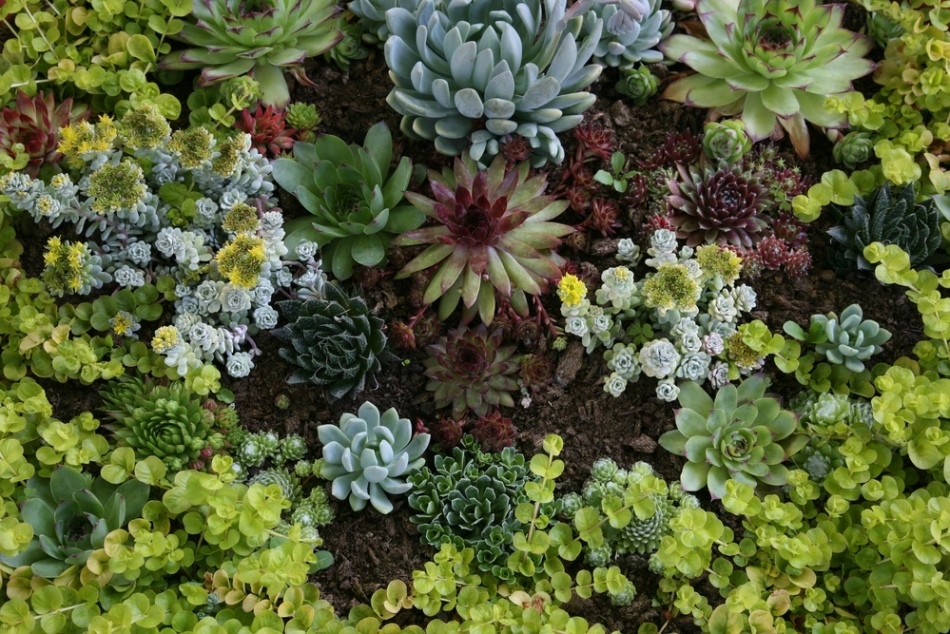 Decoration of the site
Decoration of the site 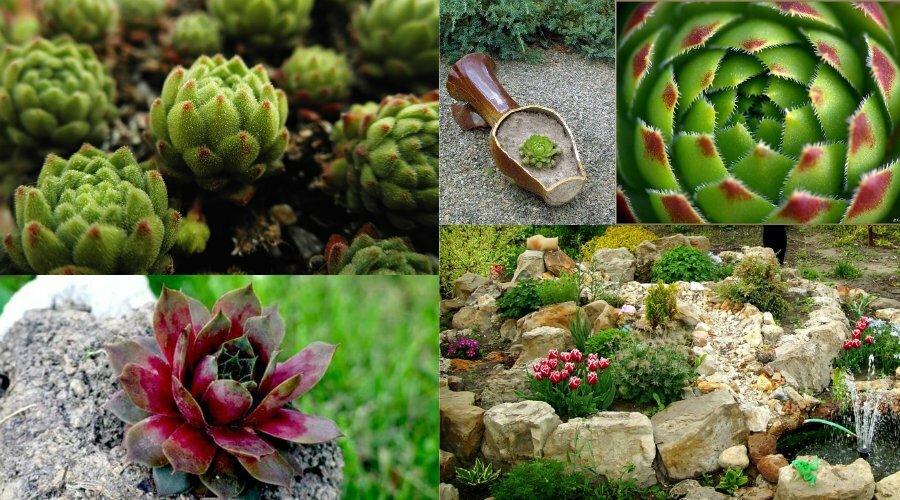 For the design of the
For the design of the It will be very beautiful to look compositions on flowerbeds from different varieties of this plant.
Thanks to him in the garden you can create a blanket, carpet or mosaic of incredible beauty.
A stone rose can also revive small rosaries.
This plant will look great in small, but unusual, unusual vases, pots and baskets.
Using a stone rose you can create a real fairy tale in the garden.
Molodilo - a flower of a stone rose in the cemetery
People in modern society are still respectful and caring towards the deceased. Therefore, very often you can see graves decorated with fresh flowers. But which flowers to choose for planting in the cemetery? Many people are concerned about this issue.
Flowers for planting on the grave should be unpretentious, hardy and perennial, so as not to transplant them every year and that they already in early spring decorate the graves of loved ones. They should not be afraid of drought, frost, or other weather changes.
Molodilo in this case is just perfect. And all because they can grow on any, even the worst soil. They are resistant to cold and drought and do not require special care.
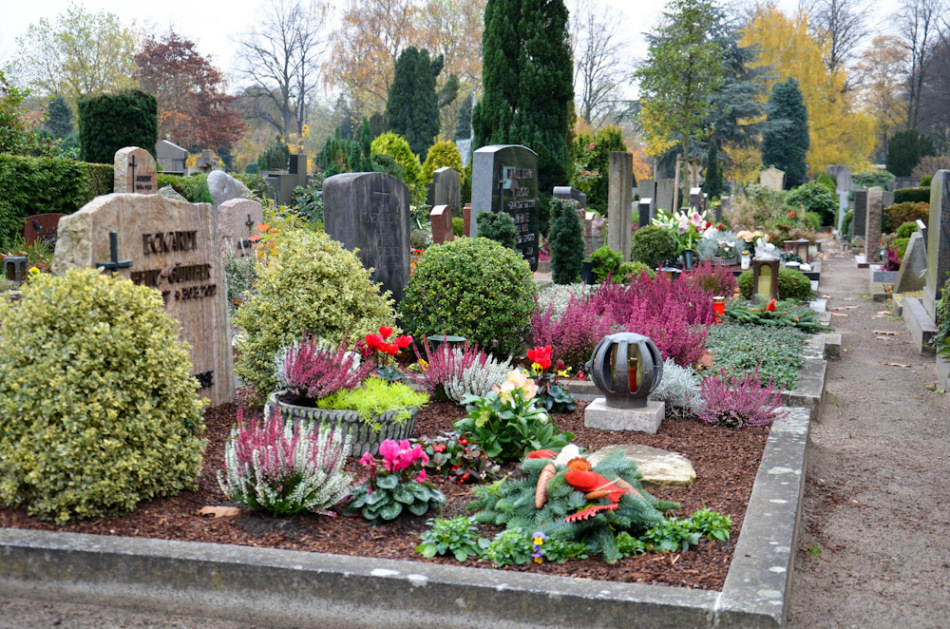 Molodilo is also planted in the cemeteries of
Molodilo is also planted in the cemeteries of . In order to grow this plant in the cemetery, you do not need anything special. Just plant the rosette of the plant in the ground, well watered before it. Well, and the first time clean up on the grave, so as not to allow the germination of weeds. And then in a short time the young would decorate the graves of people dear to you.
